Want to catch a stone basse? Talk Sea Fishing takes a comprehensive look at where to find them and the best tackle and tactics to catch one.
A rarely caught but not uncommon summer migrant to UK and Irish waters. It is a hard fighting fish that is not easily spooked and always seems pretty eager to feed. It is also called “wreckfish” as in more southern waters it is found over very rough ground, lives in deep water caves, and also around wrecks and wreckage. It’s scientific name is Polyprion Americanus, poly from Greek meaning many and prion referring to a saw which is a reference apparently to their striking spiny fins.
It is almost impossible to confuse the stone basse with anything else. It is a deep-bodied fish with an angled forehead, large eye, and a pointed snout with a protruding lower jaw. The first and second dorsal fins are joined, but the front of the dorsal, the first 11 fin filaments, being sharp spined. The cheeks are scaly and the gill cover carries a sharp spine towards the top. There is also a heavy ridge running across the gill cover. The tail is flat and broad with a minimal tail V in the centre.
The back is usually dark brown, sometimes almost black with silver sides carrying some yellow mixing and more yellow in the belly. This colouring quickly fades when out of the water. They can also carry some colour confusion in the shape of fine blotching on the back and sides.
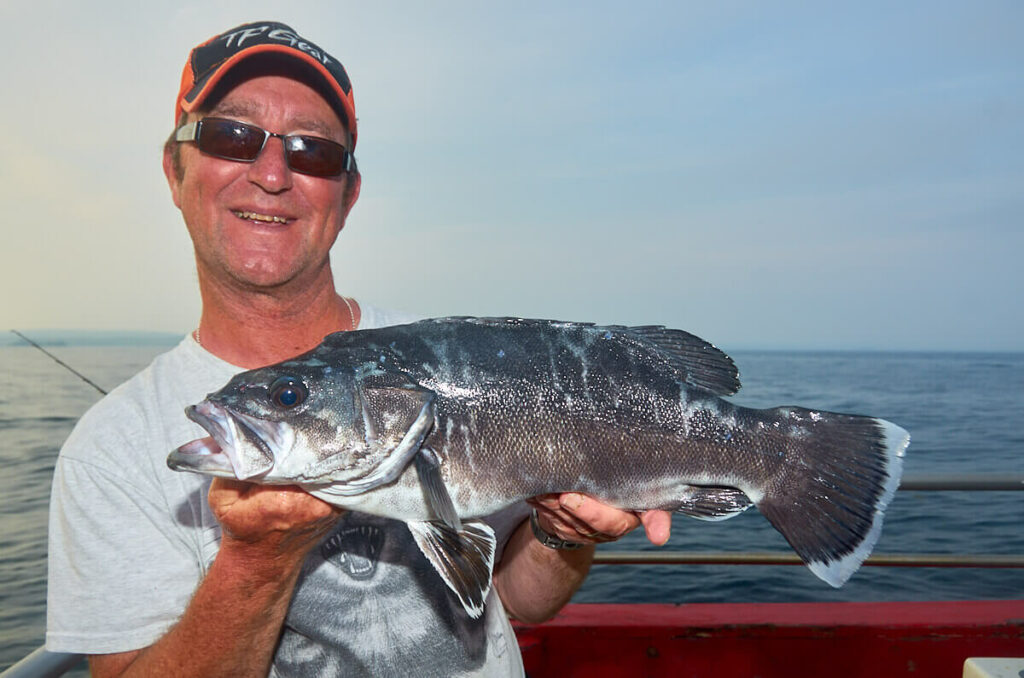
They are found throughout the Mediterranean, also in the waters off North Africa, right up the European coast and throughout the Bay of Biscay.
They are on the very northern fringe of their northward track around the British Isles and Ireland and although maybe not as uncommon as we think, they are rarely caught. Their natural push is as far as the southwest approaches of the English Channel occasionally being seen as far east as the Isle of Wight, but they are more generally taken off the Devon and Cornish coast, and occasionally seen in the southern sector of the Irish Sea.
Off Ireland, they are most common off the south coast, especially west Cork and up into Kerry. Rarely are they seen further north. This extreme northward migration edge is dependent on there being a warm spring and warmer than usual summer.
In the UK and Ireland, the majority of wreckfish are well under 20lbs and are juveniles. They are found in water usually over 300-feet deep but are resident on the surface and hiding under any floating debris such as logs, tree branches, old fish boxes or crates, also a mass of floating weed or any other floating structure, pretty much anything that gives them protection and somewhere to dart to when danger threatens.
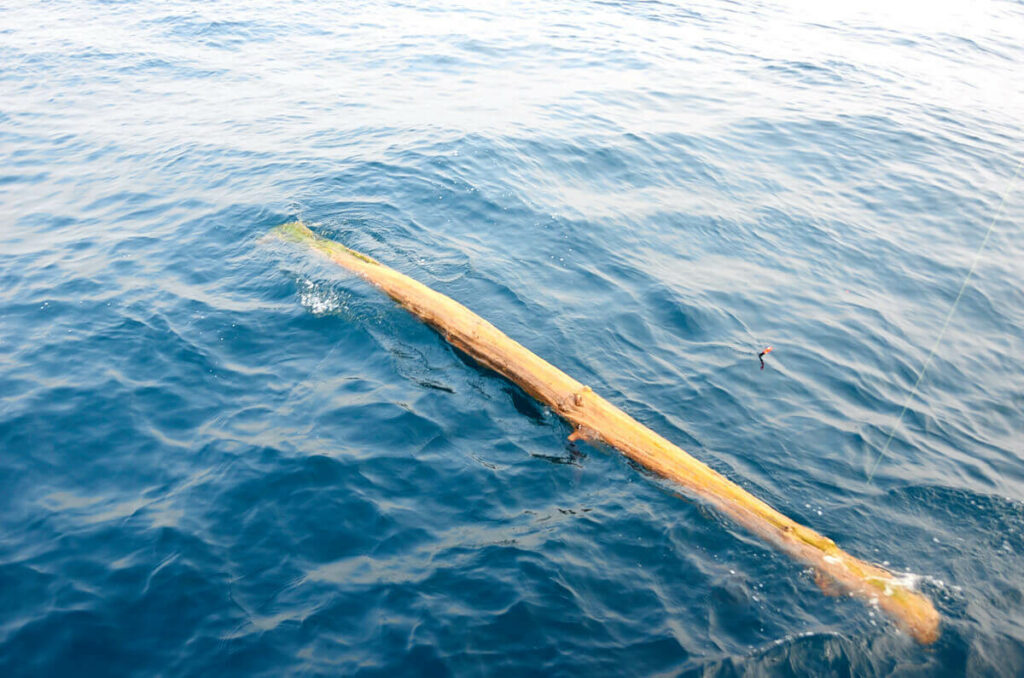
They will form small groups of between 2 and 10 fish when living under debris with the fish roughly around the same weight.
It is thought that one of the reasons that stone bass come so far north is that they stay under floating debris as it drifts north on the ocean currents. Though plausible, it seems more likely the fish are free swimming and select suitable floating debris as they travel. This is backed up by the fact that they will sit unannounced under boats drifting in deep water when there is no obvious floating debris in the vicinity.
It’s often the case that boats targeting sharks and using rubby dubby seem to attract wreckfish under the boat, which indicates they may be bottom or mid water swimming but respond to food scent trails and come up in the water to investigate.
Larger adults in more southern waters are found in water depths exceeding 400-feet and live on the bottom individually among rocks and around wrecks and rising rock pinnacles.
A typical diet is any small fish, usually mackerel, sandeels and maybe pilchards and sprat. There is also some speculation that they work the water column in deeper water attacking squid, too, as they have coughed fresh squid up.
Much depends on it being a warm spring and a good summer that sees water temperatures exceed 14c. Years when sea temps reach 16c tend to be the very best years regarding the numbers of stone basse caught.
In both the southwest of the UK and off Ireland, the earliest you see stone basse can be mid-July with the best months being August and September when sea temperatures usually peak. Once sea temps start to decline, they are quickly gone. Early October sees the last of them this far north.
With this fish being an opportunist feeder and living on the surface tides seem to have little influence on them. It could be said that they may be more active on the bigger tides, especially flood tides, but this is difficult to prove.
This increase in activity may be because as the tide flow increases, so too does the drift speed of the floating debris they are living under. This means the fish by necessity become more active swimmers to stay with the cover and start to seek food to compensate.
The best sea state for stone basse (wreckfish) are fairly flat calm conditions, almost oily flat being the best. That said, they can be taken when the sea is a little rougher, even breaking white, but they seem to disperse when the sea state is rough probably because they expend a lot more energy trying to stay in the rougher surface layers and prefer to go deep. This may also be why they suddenly appear under boats, i.e. that they left the security of some floating debris to go deep in rough weather, then as the sea calms again, they attach themselves to the first floating cover they can find.
They will take baits in most light levels too, from bright searing hot sunshine to full overcast cloud cover. Even on days with heavy rain, try fishing tight to the debris as they will take if there, providing the water is fairly clear.
Given that any stone basse you are likely to hook will be little more than 10lbs in weight, relatively light tackle can be chosen.
It may be necessary to cast away from the boat, also to play the fish under the boat during the fight, so for this reason, the longer Euro style soft tipped rods, such as the Shakespeare Tipster series, or similar, in lengths from 10 to 11ft in length are perfect. The length encourages good casting distance with lighter weights, plus the soft tip is ideal for controlling the initial powerful lunges and fast runs the fish make. You also have the length again to dip the tip under the water to avoid the line touching the boats' underside should a fish try to fight it out under the boat, which is common.
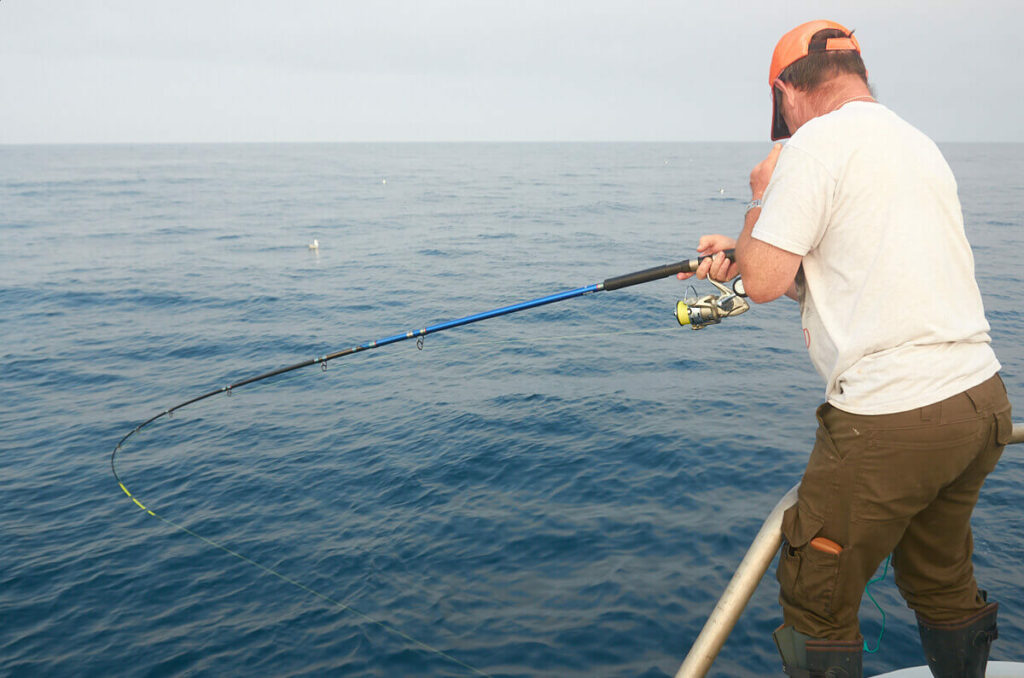
The best reels for this are 5000 to 6000 sized fixed spool reels. Go for a tough model like the Penn Slammer series or a Daiwa or Shimano equivalent that give you a powerful drag, one that will give line instantly and without hesitation. The stone bass will fight head down and take line in short bursts, so a good drag is essential.
To aid casting then a braid main line in 30lbs breaking strain is the wisest choice. If you use mono, even at short distances, it will stretch and the wreckfish has a very tough hard mouth. The stretch can see the hook point fail to penetrate and this can result in the hook falling out during the fight. The non-stretch characteristics of the braid means more power goes directly through to the hook point resulting in a better hook up ratio with deeper hook point penetration.
A shock leader is important with fluorocarbon the best choice as it offers a higher abrasion resistance than mono and the body of a wreckfish is rough enough and with sharp spines to cut through any soft material should the line touch the body. The fluorocarbon stands up to this way better due to its harder surface, it’s also less easy for the fish to see, and they do have good eyesight especially in clear water and bright sunlight and bear in mind that the fish will be targeting your bait in just a few feet of surface water.
There is no need for a rig as such for this type of fishing. The hook is tied directly to the shock leader. This gives a natural presentation which will appeal to the way the wreckfish feed as they like a free-falling natural-looking bait.
The hook size should be a 4/0 to 6/0. They do not have small mouths and can accommodate hooks of this size with ease. However, do make sure the hook is sharpened to a strong but sharp point for as we’ve said earlier their mouths are very tough and it’s not easy to get hooks to penetrate easily, even at short range.
They are not fussy feeders, but mackerel is most likely the mainstay of their diet in UK waters and this is the best bait to use. It needs to be cut into whole body sections about 3-inches in length for casting. Pass the hook point through one end of the cut body section and push it down as far as it will go, then bring it out of the skin. Just below this exit hole, push the hook point in again and down as far as it will go and bring it out. This is effectively stitching the hook in and out of the bait and this will hold it securely even for casting. Make sure the hook point is well clear of the bait for instant fish contact when striking. If the mackerel you have is older and softer, then maybe add a few turns of bait elastic to secure it in place when casting.
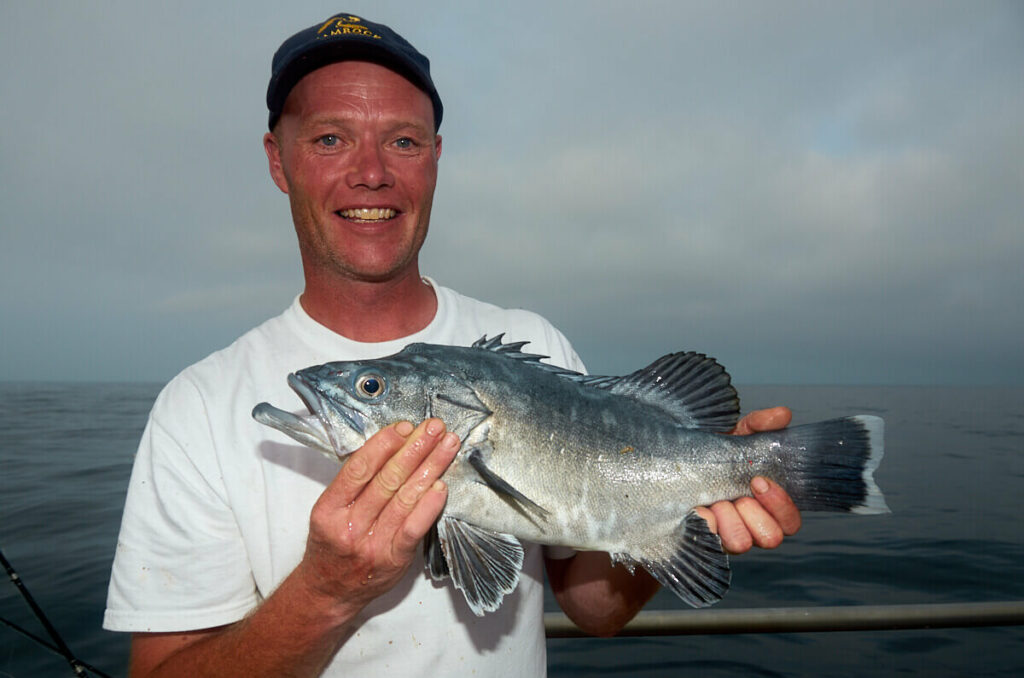
For fish that are under the boat, the better bait is a small fillet of mackerel. A good way is to cut a whole fillet off, then cut it in half at an angle through the middle to create two baits. With the tail fillet, pass the hook through the thin end down from the tip about an inch, and with the front half of the fillet, pass the hook once through one end. This will slowly flutter down in the water column but also leave bits of mackerel floating free and also small bits will fall off that excites the stone basse, though it’s the free-falling offering that carries the most appeal.
In these modern times we also seem to catch a large proportion of smaller joey mackerel just a few inches long. These are also excellent. You can just cut the tail off to stop the bait spinning and pass the hook up through the bottom and top jaw at the front to expose the hook. These cast a long way and also look natural in the water.
If the fish show no interest in the above, try cutting the tail off a joey, slicing the fillets off the backbone and remove the backbone altogether, then hook the bait through the bottom and top jaw. This will sink slower than a whole bait and the large amount of scent coming from it can trigger the fish to feed, as can twitching the bait which makes the fillets move and look like an injured fish.
Small whole squid or sections of squid will work, as will body sections of other fish such as whiting, herring and even pollack and codling, but the squid aside, these can be less successful than a fresh mackerel bait.
On the way out to the fishing grounds, also during the day and on the way back, keep a constant eye out for any floating debris. If you see some, then the tactic is to motor slowly up towards it and get within casting range, say 30 to 40yds, no more. If possible, knock the motor out of gear a little way from where you want to fish and let the speed of the boat carry you in. Wreckfish are not spooky, but a sudden change in engine note when close can agitate them.
Have a baited hook ready and cast the bait so that it lands as close to the floating debris as possible. Open the bale-arm of the reel so that line can peel off easily. Feel the bait sink down on the rod tip and you’ll feel a slight bump when the fish takes the bait. It will turn and take a few feet of free line off the reel as it goes back under the debris. As it starts to slow, flick the bale-arm back over and pull the rod sideways to strike. This will result in a lip hooked fish as they don’t just gulp the bait down.
They will instantly dive and run when they feel the hook, and will continue to run in short bursts and repeatedly turn back for the debris. As they near the boat, they will usually try to get underneath it and you need to dip the rod to keep the line away from the hull and the propeller. Just keep working the fish until it allows itself to be held on the surface, then net it. It’s important to net stone basse because the hook does not always sit deep in the jaw and weak hook holds are possible.
When casting to fish under debris, it’s important to get the bait as tight as possible to it. The fish will come out to intercept baits a little way but not much more than a few feet as they can be very cautious in leaving the sanctuary of the flotsam.
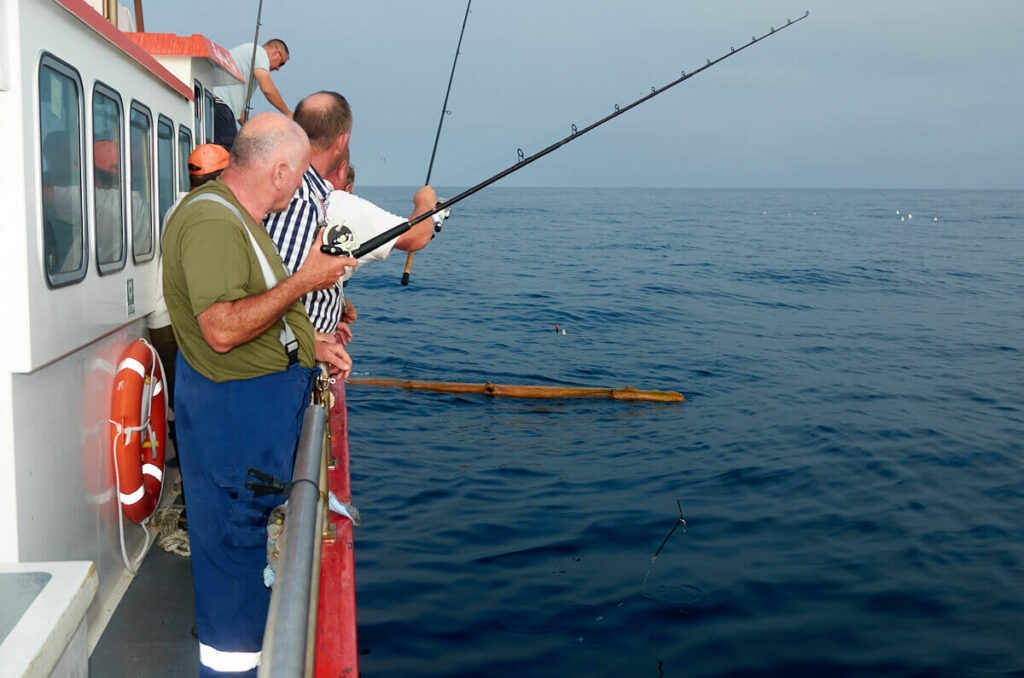
If they won’t take a free-falling bait, cast the bait tight to the debris, let it sink a few feet, then twitch it back with a small flick of the rod tip. This sudden movement can trick the wreckfish into thinking a bait is getting away, and they’ll attack.
You’ll never know a stone basse is sitting under the boat unless you tease it out. Sometimes, when shark fishing and a new bait is being dropped over the side, they will dart out and attack it. Often, a whole mackerel bait for sharks is too big for them, and they won’t commit. To check if a fish is sitting under the boat, every 20 minutes or so, drop a couple of small cubes of mackerel fillet over the side, something about 2 to 3ins long is perfect. Drop this tight to the boat’s gunnel and watch it flutter down into the water column. The fish will normally dart out and intercept the bait.
If you see a wreckfish under the boat it’s simply a matter of baiting the hook on the Euro rod and dropping the bait over the side leaving the reel bale-arm open to let the fish take line freely. Once it darts out, grabs the bait and turns back under the boat, when it stops taking line, flick the bale-arm back into gear and strike pushing the rod tip deep into the water to keep the line away from the hull. For the first couple of minutes the fight is likely to be right under the boat, but eventually the fish will break out into more open water away from the boat due to rod pressure and try to dive in short bursts. When it comes up on the surface they are capable of more crash dives, but this is unusual. Again, always net them.
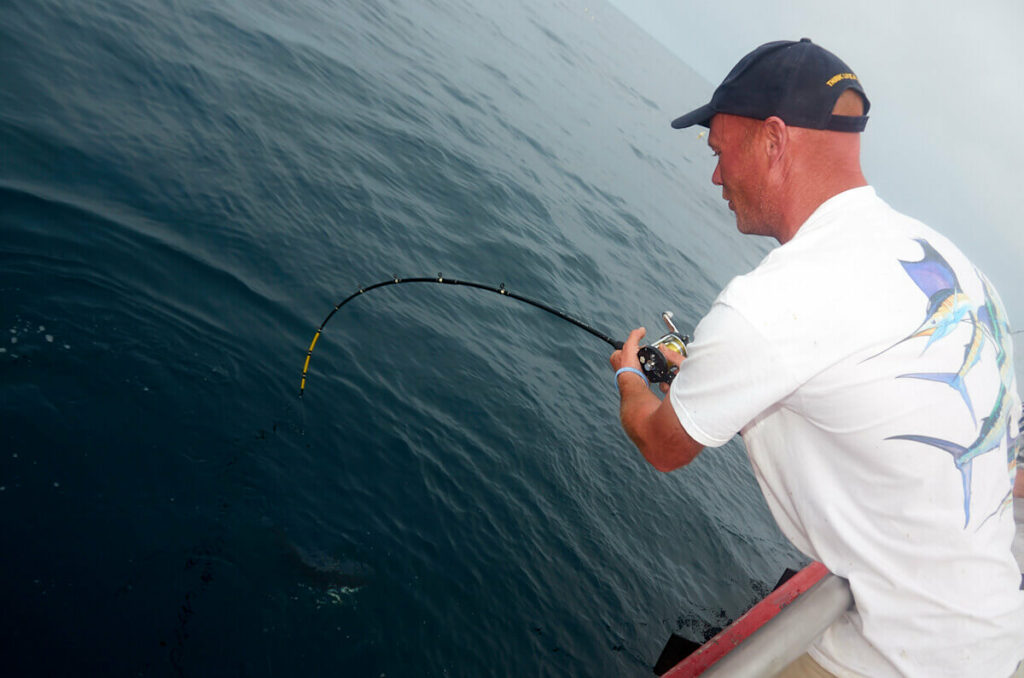
Another option to try when targeting fish that might be under the boat is to suspend a bait so that it sits 4 to 6ft below the surface. You can do this by using a piece of polystyrene about the size of a tennis ball and cut a slice a little way through it with a knife. The shock leader is then pulled down into the slice in the polystyrene to lock it in place and position the bait at the required depth. This also allows you to move the bait up and down the length of the boat’s gunnels. Again, this occasional movement can trigger any fish hidden underneath into attacking.
Don’t be tempted to be lazy and put the rod with a suspended bait into a rod holder tube on the gunnel and let it fish for itself. Stone basse are powerful and will take the bait and turn under the boat. This will over stress a rod tip when the rod is near vertical in the holder which will cause a breakage as the full pressure of the fish is solely on the relatively weak rod tip. Also, line fraying on the underside of the hull is likely, again resulting in a breakage when fighting the fish.
Wreckfish sitting under surface floating debris have also been caught on spinners. A lure about 3ins to 5ins in length and chrome coloured is best. Spoon type designs that will flutter and wobble using a slow retrieve are the very best. Cast these well beyond the debris, let it sink a little, then slowly retrieve it past the fish under the debris. Try a couple of casts, then pause for a few minutes and try again. If you repeatedly cast the fish will lose interest. Sometimes they will chase the lure, if it’s close enough, they can take it as it drops down.
Soft plastic shads with a weighted head are also good, these cast well and the rubber tail pulsing on the retrieve will home in any wreckfish.
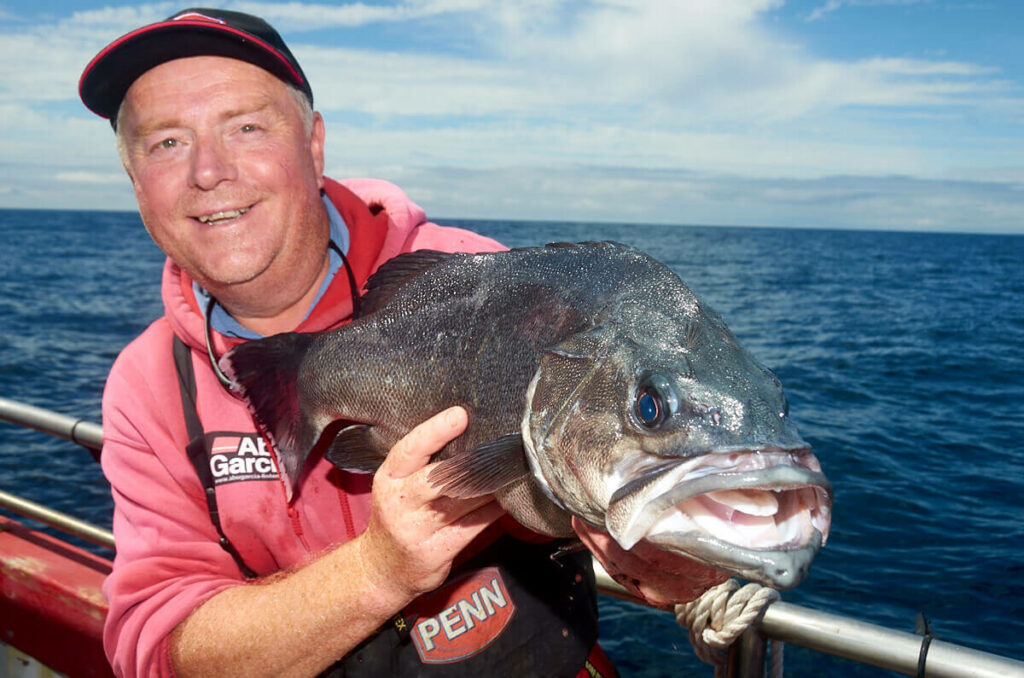
About the stone basse
A rarely caught but not uncommon summer migrant to UK and Irish waters. It is a hard fighting fish that is not easily spooked and always seems pretty eager to feed. It is also called “wreckfish” as in more southern waters it is found over very rough ground, lives in deep water caves, and also around wrecks and wreckage. It’s scientific name is Polyprion Americanus, poly from Greek meaning many and prion referring to a saw which is a reference apparently to their striking spiny fins.
Identification
It is almost impossible to confuse the stone basse with anything else. It is a deep-bodied fish with an angled forehead, large eye, and a pointed snout with a protruding lower jaw. The first and second dorsal fins are joined, but the front of the dorsal, the first 11 fin filaments, being sharp spined. The cheeks are scaly and the gill cover carries a sharp spine towards the top. There is also a heavy ridge running across the gill cover. The tail is flat and broad with a minimal tail V in the centre.
The back is usually dark brown, sometimes almost black with silver sides carrying some yellow mixing and more yellow in the belly. This colouring quickly fades when out of the water. They can also carry some colour confusion in the shape of fine blotching on the back and sides.

Distribution
They are found throughout the Mediterranean, also in the waters off North Africa, right up the European coast and throughout the Bay of Biscay.
They are on the very northern fringe of their northward track around the British Isles and Ireland and although maybe not as uncommon as we think, they are rarely caught. Their natural push is as far as the southwest approaches of the English Channel occasionally being seen as far east as the Isle of Wight, but they are more generally taken off the Devon and Cornish coast, and occasionally seen in the southern sector of the Irish Sea.
Off Ireland, they are most common off the south coast, especially west Cork and up into Kerry. Rarely are they seen further north. This extreme northward migration edge is dependent on there being a warm spring and warmer than usual summer.
Habitat
In the UK and Ireland, the majority of wreckfish are well under 20lbs and are juveniles. They are found in water usually over 300-feet deep but are resident on the surface and hiding under any floating debris such as logs, tree branches, old fish boxes or crates, also a mass of floating weed or any other floating structure, pretty much anything that gives them protection and somewhere to dart to when danger threatens.

They will form small groups of between 2 and 10 fish when living under debris with the fish roughly around the same weight.
It is thought that one of the reasons that stone bass come so far north is that they stay under floating debris as it drifts north on the ocean currents. Though plausible, it seems more likely the fish are free swimming and select suitable floating debris as they travel. This is backed up by the fact that they will sit unannounced under boats drifting in deep water when there is no obvious floating debris in the vicinity.
It’s often the case that boats targeting sharks and using rubby dubby seem to attract wreckfish under the boat, which indicates they may be bottom or mid water swimming but respond to food scent trails and come up in the water to investigate.
Larger adults in more southern waters are found in water depths exceeding 400-feet and live on the bottom individually among rocks and around wrecks and rising rock pinnacles.
Diet
A typical diet is any small fish, usually mackerel, sandeels and maybe pilchards and sprat. There is also some speculation that they work the water column in deeper water attacking squid, too, as they have coughed fresh squid up.
Season
Much depends on it being a warm spring and a good summer that sees water temperatures exceed 14c. Years when sea temps reach 16c tend to be the very best years regarding the numbers of stone basse caught.
In both the southwest of the UK and off Ireland, the earliest you see stone basse can be mid-July with the best months being August and September when sea temperatures usually peak. Once sea temps start to decline, they are quickly gone. Early October sees the last of them this far north.
Tides
With this fish being an opportunist feeder and living on the surface tides seem to have little influence on them. It could be said that they may be more active on the bigger tides, especially flood tides, but this is difficult to prove.
This increase in activity may be because as the tide flow increases, so too does the drift speed of the floating debris they are living under. This means the fish by necessity become more active swimmers to stay with the cover and start to seek food to compensate.
Weather patterns
The best sea state for stone basse (wreckfish) are fairly flat calm conditions, almost oily flat being the best. That said, they can be taken when the sea is a little rougher, even breaking white, but they seem to disperse when the sea state is rough probably because they expend a lot more energy trying to stay in the rougher surface layers and prefer to go deep. This may also be why they suddenly appear under boats, i.e. that they left the security of some floating debris to go deep in rough weather, then as the sea calms again, they attach themselves to the first floating cover they can find.
They will take baits in most light levels too, from bright searing hot sunshine to full overcast cloud cover. Even on days with heavy rain, try fishing tight to the debris as they will take if there, providing the water is fairly clear.
Stone basse tackle
Given that any stone basse you are likely to hook will be little more than 10lbs in weight, relatively light tackle can be chosen.
It may be necessary to cast away from the boat, also to play the fish under the boat during the fight, so for this reason, the longer Euro style soft tipped rods, such as the Shakespeare Tipster series, or similar, in lengths from 10 to 11ft in length are perfect. The length encourages good casting distance with lighter weights, plus the soft tip is ideal for controlling the initial powerful lunges and fast runs the fish make. You also have the length again to dip the tip under the water to avoid the line touching the boats' underside should a fish try to fight it out under the boat, which is common.

The best reels for this are 5000 to 6000 sized fixed spool reels. Go for a tough model like the Penn Slammer series or a Daiwa or Shimano equivalent that give you a powerful drag, one that will give line instantly and without hesitation. The stone bass will fight head down and take line in short bursts, so a good drag is essential.
To aid casting then a braid main line in 30lbs breaking strain is the wisest choice. If you use mono, even at short distances, it will stretch and the wreckfish has a very tough hard mouth. The stretch can see the hook point fail to penetrate and this can result in the hook falling out during the fight. The non-stretch characteristics of the braid means more power goes directly through to the hook point resulting in a better hook up ratio with deeper hook point penetration.
A shock leader is important with fluorocarbon the best choice as it offers a higher abrasion resistance than mono and the body of a wreckfish is rough enough and with sharp spines to cut through any soft material should the line touch the body. The fluorocarbon stands up to this way better due to its harder surface, it’s also less easy for the fish to see, and they do have good eyesight especially in clear water and bright sunlight and bear in mind that the fish will be targeting your bait in just a few feet of surface water.
Stone basse rigs
There is no need for a rig as such for this type of fishing. The hook is tied directly to the shock leader. This gives a natural presentation which will appeal to the way the wreckfish feed as they like a free-falling natural-looking bait.
The hook size should be a 4/0 to 6/0. They do not have small mouths and can accommodate hooks of this size with ease. However, do make sure the hook is sharpened to a strong but sharp point for as we’ve said earlier their mouths are very tough and it’s not easy to get hooks to penetrate easily, even at short range.
Baits for stone basse
They are not fussy feeders, but mackerel is most likely the mainstay of their diet in UK waters and this is the best bait to use. It needs to be cut into whole body sections about 3-inches in length for casting. Pass the hook point through one end of the cut body section and push it down as far as it will go, then bring it out of the skin. Just below this exit hole, push the hook point in again and down as far as it will go and bring it out. This is effectively stitching the hook in and out of the bait and this will hold it securely even for casting. Make sure the hook point is well clear of the bait for instant fish contact when striking. If the mackerel you have is older and softer, then maybe add a few turns of bait elastic to secure it in place when casting.

For fish that are under the boat, the better bait is a small fillet of mackerel. A good way is to cut a whole fillet off, then cut it in half at an angle through the middle to create two baits. With the tail fillet, pass the hook through the thin end down from the tip about an inch, and with the front half of the fillet, pass the hook once through one end. This will slowly flutter down in the water column but also leave bits of mackerel floating free and also small bits will fall off that excites the stone basse, though it’s the free-falling offering that carries the most appeal.
In these modern times we also seem to catch a large proportion of smaller joey mackerel just a few inches long. These are also excellent. You can just cut the tail off to stop the bait spinning and pass the hook up through the bottom and top jaw at the front to expose the hook. These cast a long way and also look natural in the water.
If the fish show no interest in the above, try cutting the tail off a joey, slicing the fillets off the backbone and remove the backbone altogether, then hook the bait through the bottom and top jaw. This will sink slower than a whole bait and the large amount of scent coming from it can trigger the fish to feed, as can twitching the bait which makes the fillets move and look like an injured fish.
Small whole squid or sections of squid will work, as will body sections of other fish such as whiting, herring and even pollack and codling, but the squid aside, these can be less successful than a fresh mackerel bait.
Stone basse techniques
On the way out to the fishing grounds, also during the day and on the way back, keep a constant eye out for any floating debris. If you see some, then the tactic is to motor slowly up towards it and get within casting range, say 30 to 40yds, no more. If possible, knock the motor out of gear a little way from where you want to fish and let the speed of the boat carry you in. Wreckfish are not spooky, but a sudden change in engine note when close can agitate them.
Have a baited hook ready and cast the bait so that it lands as close to the floating debris as possible. Open the bale-arm of the reel so that line can peel off easily. Feel the bait sink down on the rod tip and you’ll feel a slight bump when the fish takes the bait. It will turn and take a few feet of free line off the reel as it goes back under the debris. As it starts to slow, flick the bale-arm back over and pull the rod sideways to strike. This will result in a lip hooked fish as they don’t just gulp the bait down.
They will instantly dive and run when they feel the hook, and will continue to run in short bursts and repeatedly turn back for the debris. As they near the boat, they will usually try to get underneath it and you need to dip the rod to keep the line away from the hull and the propeller. Just keep working the fish until it allows itself to be held on the surface, then net it. It’s important to net stone basse because the hook does not always sit deep in the jaw and weak hook holds are possible.
When casting to fish under debris, it’s important to get the bait as tight as possible to it. The fish will come out to intercept baits a little way but not much more than a few feet as they can be very cautious in leaving the sanctuary of the flotsam.

If they won’t take a free-falling bait, cast the bait tight to the debris, let it sink a few feet, then twitch it back with a small flick of the rod tip. This sudden movement can trick the wreckfish into thinking a bait is getting away, and they’ll attack.
You’ll never know a stone basse is sitting under the boat unless you tease it out. Sometimes, when shark fishing and a new bait is being dropped over the side, they will dart out and attack it. Often, a whole mackerel bait for sharks is too big for them, and they won’t commit. To check if a fish is sitting under the boat, every 20 minutes or so, drop a couple of small cubes of mackerel fillet over the side, something about 2 to 3ins long is perfect. Drop this tight to the boat’s gunnel and watch it flutter down into the water column. The fish will normally dart out and intercept the bait.
If you see a wreckfish under the boat it’s simply a matter of baiting the hook on the Euro rod and dropping the bait over the side leaving the reel bale-arm open to let the fish take line freely. Once it darts out, grabs the bait and turns back under the boat, when it stops taking line, flick the bale-arm back into gear and strike pushing the rod tip deep into the water to keep the line away from the hull. For the first couple of minutes the fight is likely to be right under the boat, but eventually the fish will break out into more open water away from the boat due to rod pressure and try to dive in short bursts. When it comes up on the surface they are capable of more crash dives, but this is unusual. Again, always net them.

Another option to try when targeting fish that might be under the boat is to suspend a bait so that it sits 4 to 6ft below the surface. You can do this by using a piece of polystyrene about the size of a tennis ball and cut a slice a little way through it with a knife. The shock leader is then pulled down into the slice in the polystyrene to lock it in place and position the bait at the required depth. This also allows you to move the bait up and down the length of the boat’s gunnels. Again, this occasional movement can trigger any fish hidden underneath into attacking.
Don’t be tempted to be lazy and put the rod with a suspended bait into a rod holder tube on the gunnel and let it fish for itself. Stone basse are powerful and will take the bait and turn under the boat. This will over stress a rod tip when the rod is near vertical in the holder which will cause a breakage as the full pressure of the fish is solely on the relatively weak rod tip. Also, line fraying on the underside of the hull is likely, again resulting in a breakage when fighting the fish.
Wreckfish sitting under surface floating debris have also been caught on spinners. A lure about 3ins to 5ins in length and chrome coloured is best. Spoon type designs that will flutter and wobble using a slow retrieve are the very best. Cast these well beyond the debris, let it sink a little, then slowly retrieve it past the fish under the debris. Try a couple of casts, then pause for a few minutes and try again. If you repeatedly cast the fish will lose interest. Sometimes they will chase the lure, if it’s close enough, they can take it as it drops down.
Soft plastic shads with a weighted head are also good, these cast well and the rubber tail pulsing on the retrieve will home in any wreckfish.

Top tips for stone basse fishing
- If the fish can be seen under floating debris, which is often the case especially if you climb up on to the bow for more height, but seem reluctant to take, try throwing a couple of free mackerel bait offerings to them and let them get interested before casting a bait.
- It’s always worth having two or three anglers ready with baited hooks. As one fish is hooked and led away from the debris, another angler can cast and is also likely to get a hook up. Having three or four anglers all hooked up at once is not unusual as the wreckfish do not spook easily and will remain under their surface debris ceiling.
- When you drop baits over the side of the boat to see if any fish dart out, do this on alternative sides of the boat. The fish seem to swim in slow small circles under the boat and can sometimes miss baits that sink quickly if they are not immediately in their vision field. Also, make a point of splashing one or two baits in. The fish seem to pick up on this and are more alert.

